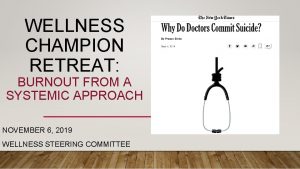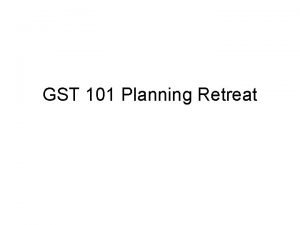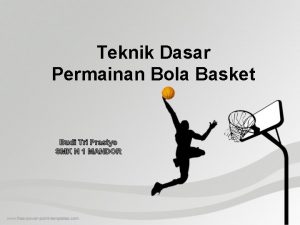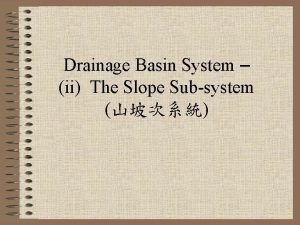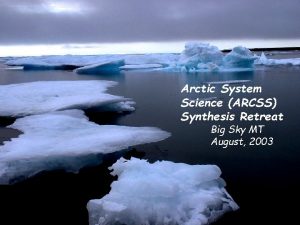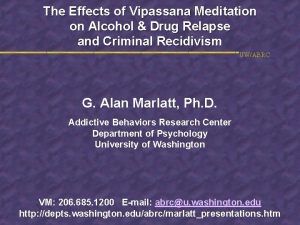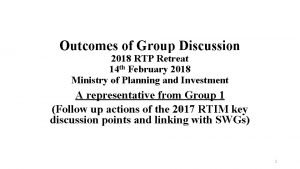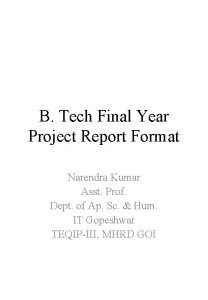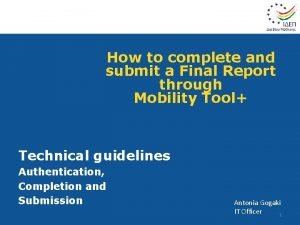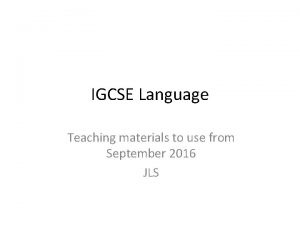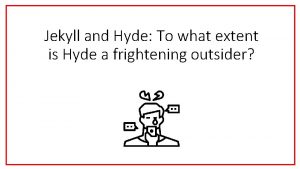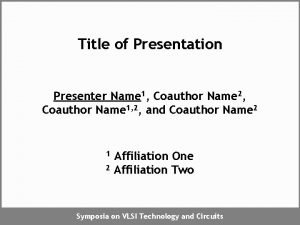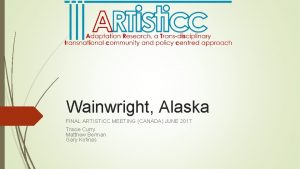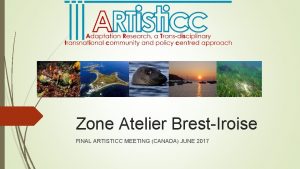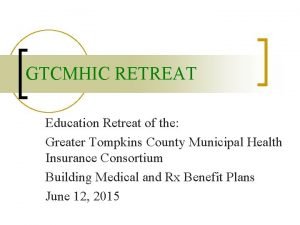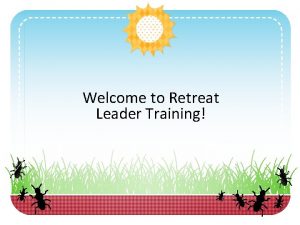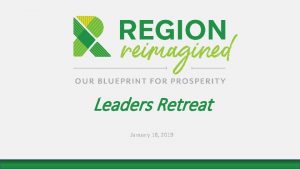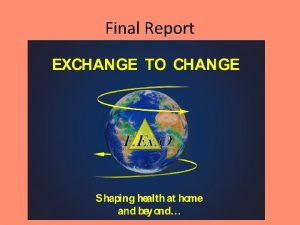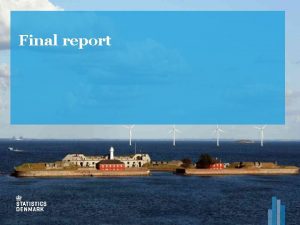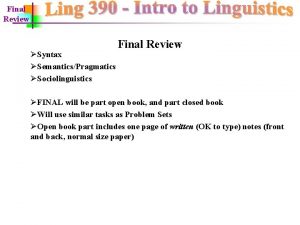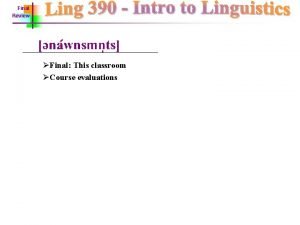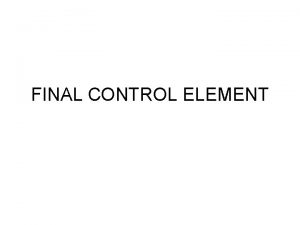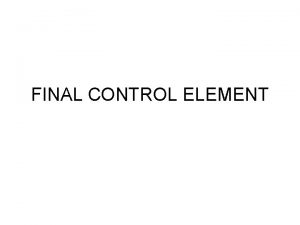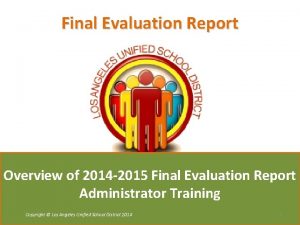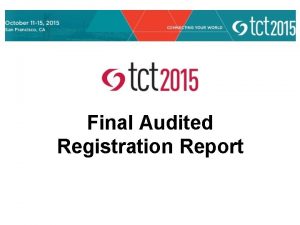Report presented at the Final Retreat of ARTISTICC





















- Slides: 21

Report presented at the Final Retreat of ARTISTICC at New Brunswick, Canada - June 18 -23 Prof. Dr. K. T. Thomson Principal Investigator (ARTISTICC-India) School of Industrial Fisheries, Cochin University of Science and Technology, Cochin, Kerala, India

Climate Change Adaptation: Definition of ARTISTICC • Adaptation of coastal communities is an intertemporal socio cultural process that they compose through negotiations within the limits of various material opportunities and semiotic constraints associated to climate variability/change • A social innovation subject to risks and uncertainties under various climate scenarios.

Using science to foster local coastal adaptation GOAL 1 Develop a multi disciplinary knowledge system through fieldworks rooted in Natural Sciences, Social Sciences and Humanities, in highly diverse Settings Two south Indian states: Kerala and Tamilnadu -Three districts: Ernakulum, Kanyakumari and Nagapattinam

Impacts Physical/Bio-ecological Socioeconomic Beach erosion & flooding Decrease in the quantity and quality of primary Degradation of fresh production (fish, water resources agriculture and Salinity Intrusion aquaculture) Unpredictability of Damage to property seasonal winds and (craft and gears, landing waves space, land, housing, Uneven precipitation Fishery relocation and private/public property Loss of employment migration Loss of biodiversity and loss of fresh water Resource conflicts coastal processes Institutional Changes in community based organizations, trade unions and political alliance Introduction of new formal institutions

Autonomous adaptation households Transition from thatched to tiled and to terraced houses Salt resistant materials for construction-baked and cement bricks Houses shifted to elevated places elevated flooring for houses High cost of repair and maintain private property and livelihood assets Fishing Sector Intensified industrial deep sea fisheries Increased mobility of fishing fleet and escalating operational cost Collapse of sardine fishery and occupational diversification Marine fishermen shifted to inland fishing Development of new fisheries due to relocation of resources Agriculture Shift to non-agriculture jobs Shift from agriculture to aquaculture Agriculture labour to estuarine workers Shift in paddy varieties and practice of mixed cropping

Planned adaptation Land reforms in the 1960 s Construction of sea wall, harbour, groins, elevated roads Food distribution by village office during natural calamities Subsidy, insurance for crop failure, loan waiver schemes Sand dunes Interactive (Second order) Cooperative adaption Customary rights like Kalakkipidutham Community lead construction of retained walls Home stead cultivation Public distribution of water Planting of mangroves built by local bodies

GOAL 2: How to compose the art of adaptation • Science communication workshops with communities, scientists and policy makers Engaging local communities and artists • Organize camps for training local artists with the leadership of People’s Research Council and Compiled paintings of local artistes Courtesy hues n reeds • Conducted awareness programmes and competitions for students • Conducted competition for photographers

The proposed artwork of ARTISTICC • Procession of art theatre along 20 kilometer long coastal belt of Vypin Island mobilizing maximum people – Major junctions, designated places, schools and religious centers • Secular enrollment, interessment and mobilization • The theatric procession cum campaign with small skits of the social and cultural signs • The theatric performance which will prolong for one and a half hours at a selected location for effective communication will soon be organised

Categories of art forms • Oral tradition (Story telling, songs, folk literature) • Dance, music and drama, sculpture, paintings and films • Story telling – Chakkyar Koothu, Kathaprasangam, Folk songs • Dance and Music and Drama – Thullal, Maargam kali, Oppana etc • Dance drama (kakkirissi nadakam, kanniar kali, padayani, kathakali, chavittu nadakam etc.

Chavittu Nadakam Padayani Poraatu Naadakam Chakyar Koothu Thullal Maargam Kali

GOAL 3: Co-construction of innovative policy briefs • Co-construction refers to participation of stakeholderscommunities, state, market and civil society- in the design of public policy. • To begin the exercise, Artisticc-India followed a participatory approach right from the beginning of the project activities – Forming a janakeeya gaveshana samithi – Meetings and research organized under their leadership and approval – Networking with scientist and policy makers established under their leadership – Network expanded as research progressed – Climate science communication through cultural activities of students – Connections with local MLA established – Newsletter highlighting major findings of the study is prepared and shared with stakeholders – Final policy making workshop conducted at Vypin island on 29 th April 2017



Epistemic communities Institutions State/Community/NGOs Let's Co-construct a Climate Change Adaptation Policy Community Markets

Artisticc’s approach to adaptation policy making • An experimental model for the co construction adaptation policy is set in Vypin Island • Local MLA is leading the exercise • First level deliberative interactions conducted on 29 th April at Cherai beach • Around 300 participants to attend in this mega consultation on participatory policy making • Similar exercises will be conducted at other locations also • Final policy brief will be based on these co construction consultations and deliberations

Results of Deliberations 1 Policies to sustain quality of life, habitats and assets • Appropriate modification of Coastal Zone Regulation Act is necessary to construct houses for poor coastal people to keep them safe during storms and extreme events. • Policy to regulate plastic to be enforced strictly • Policy to attract young people to fishery sector is necessary. • Official enquiry required to identify the wealth relocation due to climate change. • Annual maintenance of canals by local governments and irrigation department is crucial to maintain water quality • State Pollution Control Board should take strong action against the discharge of effluents to prevent high morbidity of fish. • Inappropriate methods of fishing should be discouraged. • It is also necessary to avoid the violation of socially evolved rules of fishing

2 Adaptation Policies in fisheries • Informal institutions to prevent juvenile fishing • Government should conduct detailed studies on how climate change has induced relocation of several species in the marine and inland water bodies. eg. (Sardine, prawn etc. towards backwater and sardine towards east coast). • In the changing scenario, new rules are necessary in the method and timing of fishing, sharing of fisheries, trade and marketing of fish. • Regulation of juvenile overfishing is to be introduced • The newly emerged ‘consensus rules’ of catching (like ban on night fishing) shall be implemented. • Small fishes should be excluded from fishing. – It is understood that the fry of sardine is supplied for the growth of prawn in other states. One kilogram prawn requires 4 Kg sardine

2 Adaptation Policies in fisheries Fishing should be confined only from dawn to desk One team should only go to fishing once in a day Night light fishing should be avoided Sales of night catch should not be allowed The vehicles carrying fry of sardine must be stopped. There should be monitoring committees at every landing spots to discourage the transport of fry of fishes. • Local, district, state and regional (inter-state) monitoring committees are imminent to control over fishing. • Social enterprises to be promoted in inter-state marketing of fish to share the benefits of relocation of fishery wealth • • •

3 Adaptation Policies in Aquaculture • One paddy one fish’ must be promoted. • Fish farming need to be popularised to tide over shortage of fish. • Strong interference of formal system is pertinent to eliminate the menace of adding poison to wetlands for catching fish in an unsustainable way. • Clear institutional arrangement to revert aquaculture to paddy fields by the middle of every April needed

Adaptive measures for sea level rise • Since climate change has become a people-centric issue, awareness must be generated among communities. • Multi-level disaster management cells have to be instituted. Local people should get priority and training in rescue operations • CRZ should be amended by prioritizing the needs of the local communities and costal ecology. • The communities demanded to revamp the existing sea wall construction in their locality. They urged for better alternatives like groins. • A combination of mitigation and adaptation measures needs to be designed to overcome stress of climate change.

sea level rise and adaptation • Planting and nurturing of bio-shields like mangroves along the Pokkali rice fields to control floods and to manage tidal flows is needed. • The viability of afforestation in the coastal regions to be explored and introduced • Coastal protection groups should be formed from the coastal communities to strengthen the rescue operations. • Effective water management is essential to control the floods in the region. Priority should be given for conservation of water in the homes.
 Physician burnout retreat
Physician burnout retreat Atmana vindyate viryam
Atmana vindyate viryam Retreat evaluation form
Retreat evaluation form Charade
Charade Apa pengertian dribling menurut vic ambler(2005: 10)
Apa pengertian dribling menurut vic ambler(2005: 10) What is slope decline
What is slope decline Synthesis retreat cost
Synthesis retreat cost Olc technical services retreat
Olc technical services retreat Vipassana 10 day silent retreat substance abuse
Vipassana 10 day silent retreat substance abuse Envy in the masque of the red death
Envy in the masque of the red death Retreat at rtp
Retreat at rtp Final design report
Final design report Ecas mobility tool
Ecas mobility tool Acknowledgement for b tech final year project
Acknowledgement for b tech final year project Mobility tool+ final report
Mobility tool+ final report Markstrat vodite strategy
Markstrat vodite strategy How to make final year project presentation
How to make final year project presentation Young and dyslexic analysis essay
Young and dyslexic analysis essay Presented below
Presented below Text structure baby
Text structure baby How is hyde presented as a frightening outsider
How is hyde presented as a frightening outsider Presentation name
Presentation name
